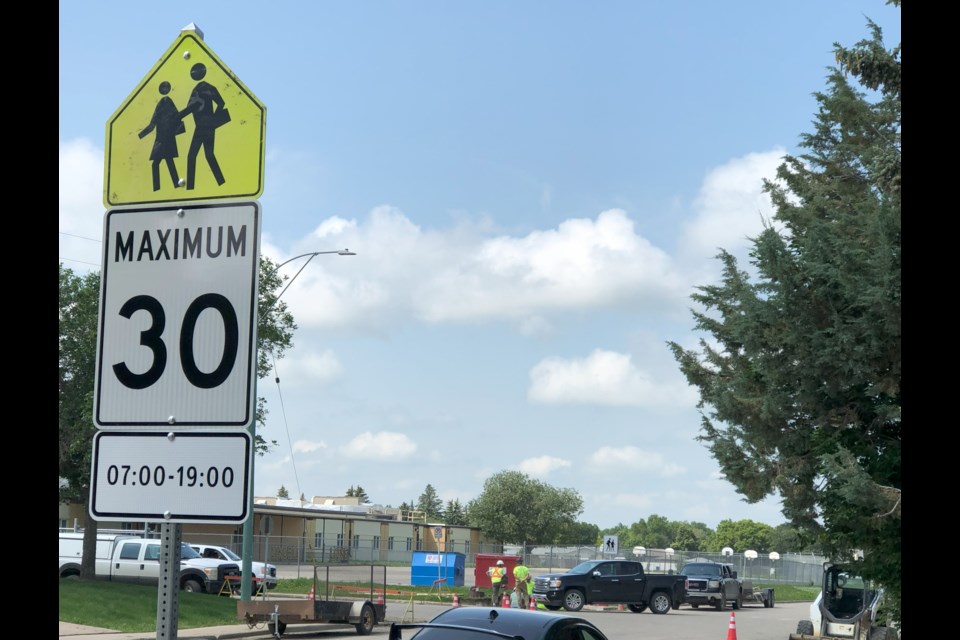The City of Moose Jaw and the Moose Jaw Police Service are advising residents that the Safe Routes to School project has begun, which includes reducing speeds in school zones.
The project is part of the amended traffic bylaw that city council officially adopted during its June 24 regular meeting. The amended bylaw reduces speeds in school zones from 40 kilometres per hour to 30 km/h and makes them effective from 7 a.m. to 7 p.m., seven days a week.
The signs will state the time as 07:00 to 19:00 — military time — which is a typical standard but also intentional and done out of respect for 15 Wing Airbase because of its connection to the community, according to city hall.
“To improve safety within our school zones and to create uniformity with the provincial standard set by all other Saskatchewan municipalities, the City of Moose Jaw will adjust school-zone speed limits to 30 km/h,” the city said. “The changes will come into effect in each zone immediately once the respective signage has been changed to reflect the new 30 km/h limit.”
City crews have begun installing new signposts and signs around school zones to reflect the recent bylaw changes. The project will affect all elementary schools and high schools and take roughly two months to complete.
The municipality also plans to reduce the speed limit in all playground zones to 30 km/h and will begin changing signs in those areas in 2025.
During the school-focused installation period, police will offer a grace period in areas that have newly installed 30 km/h signs to help educate the public about the new speed restrictions. However, officers will continue to issue tickets if vehicle speeds are more than the previously posted 40 km/h.
The grace period will continue until 11:59 p.m. on Monday, Sept. 2, and then go into effect on Tuesday, Sept. 3, when the new school year begins. After this, officers will enforce all zones according to the signs posted in those locations.
“Warnings will be issued — within reason — to allow for drivers to adjust to the changes,” the city said. “It is expected that all drivers will be aware of, and fully comply with, the new speed limit by the start of the 2024-25 school year.”
Police are reminding residents that while elementary schools and high schools have concluded for the summer, they should use caution when driving through those areas because children may be present. Moreover, school zones are in effect year-round, so police may issue tickets if they catch anyone going faster than the posted speed limit.
Speed limit times
“This (speed-zone) adjustment is by far the most cost-effective traffic control mechanism applicable for all elementary and high schools in the city. The impact to drivers is literally seconds of their day as they pass through a school zone,” the city says on its website.
The web page lists some schools and the seconds it takes motorists to pass through those areas at current speeds, reduced speeds and the time difference:
- Central Collegiate (300-metre-long zone): 27 seconds / 35.9 seconds / 8.9 seconds
- Riverview Collegiate and Empire Elementary (440-metre-long zone): 39.6 sec / 52.6 sec / 13 sec
- Prince Arthur (230-metre-long zone): 20.7 sec / 27.5 sec / 6.8 sec
- Sunningdale (311-metre-long zone): 28 sec / 37.2 sec / 9.2 sec
- Cornerstone (220-metre-long zone): 19.8 sec / 26.3 sec / 6.5 sec
- King George (200-metre-long zone): 18 sec / 23.9 sec / 5.9 sec
- William Grayson (340-metre-long zone on Caribou Street): 30.6 sec / 40.7 sec / 10.1 sec
The city began changing the school-zone signs on July 2 and started with Lindale Elementary School; there are 20 zones in total, with William Grayson the final area the city will address.




